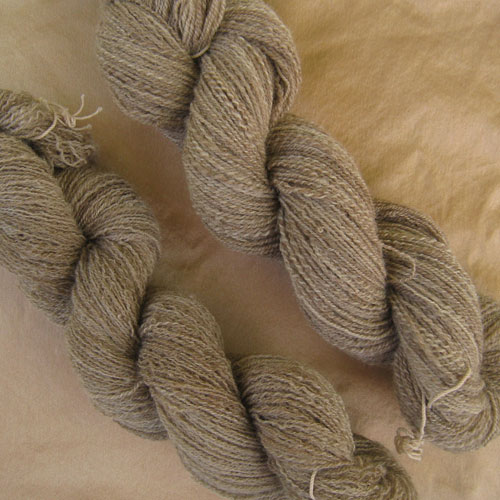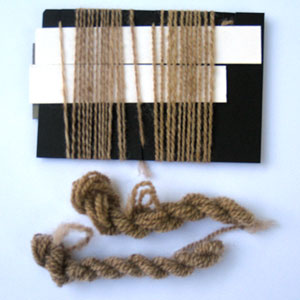

Above: Skein 1 (lower) & 2 (upper) on silk handkerchief, all dyed with hazelnut leaves. (See Progress 3 for details.)
Left: Before and after dyeing. On the card: left is before washing/dyeing/fulling; right is after. In skeins: before is the bottom skein; after is the top skein.
Yarn Specs (skein #2):
Weight: 40 grams*
Yardage: 170 yards (1925 ypp**)
WPI: 20***
The color shift is very subtle. Overall impression of sage green and deeper in tone. It really highlighted the light/dark moorit variation in the yarn. It’s not as green as the un-mordanted sample. I don’t know if it’s due to the alum or the proportions, since I didn’t weight the original sample: a skein and a handful of leaves.
I have taken to dropping a silk handkerchief into every dye pot so that I can keep a record of all the dye experiments. I purchase the handkerchiefs from Thai Silks/Exotic Silks in Los Altos. Now, I just need to get around to labeling them.
The yarn spun from the combed preparation (skein #2) is much more consistent and has more bounce. It just generally feel better. This is the yarn that I will use for the contest.
* Yes, I seem to have lost 5 grams between the time it came off of the spindle and when it came out of the dye bath. A few reasons for this. (1) My scale only records to the nearest 5 grams. (2) I took several yards off for record keeping: before/after dyeing for card record and skein for submission. Between the two, I must have teetered from closer to 45 grams to closer to 40 grams. One of these days, I’ll spring for a scale with better accuracy. For now, it gets me in the ball park.
** Measurement taken by the McMorran Balance. For some reason, it was really static-y when I was doing my measurements. I had to spray the outside of the balance with water to prevent the yarn from clinging to the balance and throwing off the measurements.
*** I did a little bit of fulling while washing the fiber, hence the change from 24 to 20 wpi. It bloomed a bit. Yes, it was intentional.


 It was a great weekend. Deb was wonderful: a great teacher and a great hostess. We laughed the entire weekend. Saturday night, we laughed so hard, I cried, then my stomach muscles hurt.
It was a great weekend. Deb was wonderful: a great teacher and a great hostess. We laughed the entire weekend. Saturday night, we laughed so hard, I cried, then my stomach muscles hurt.